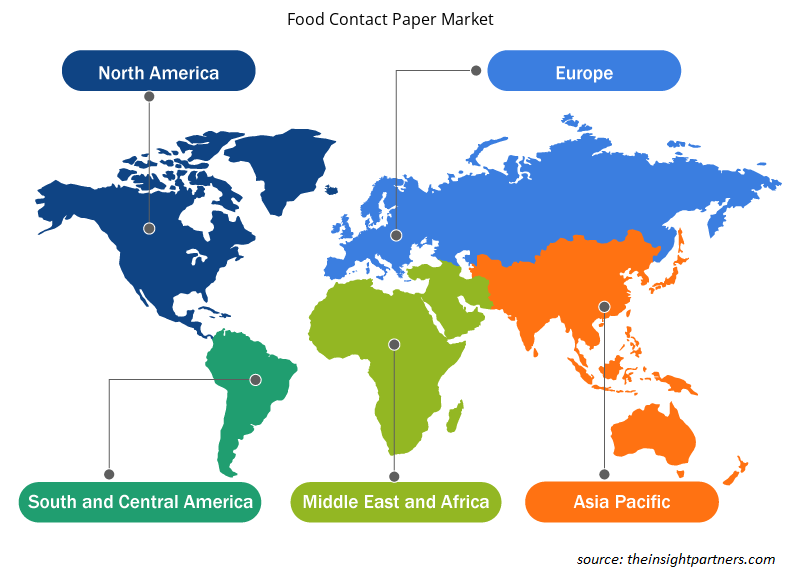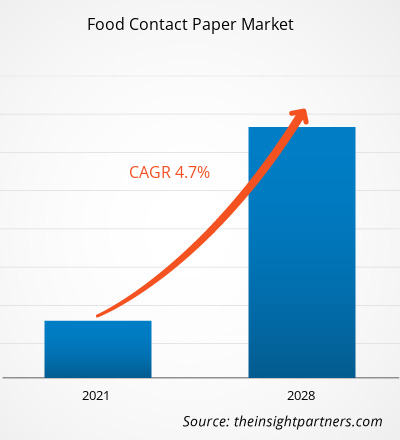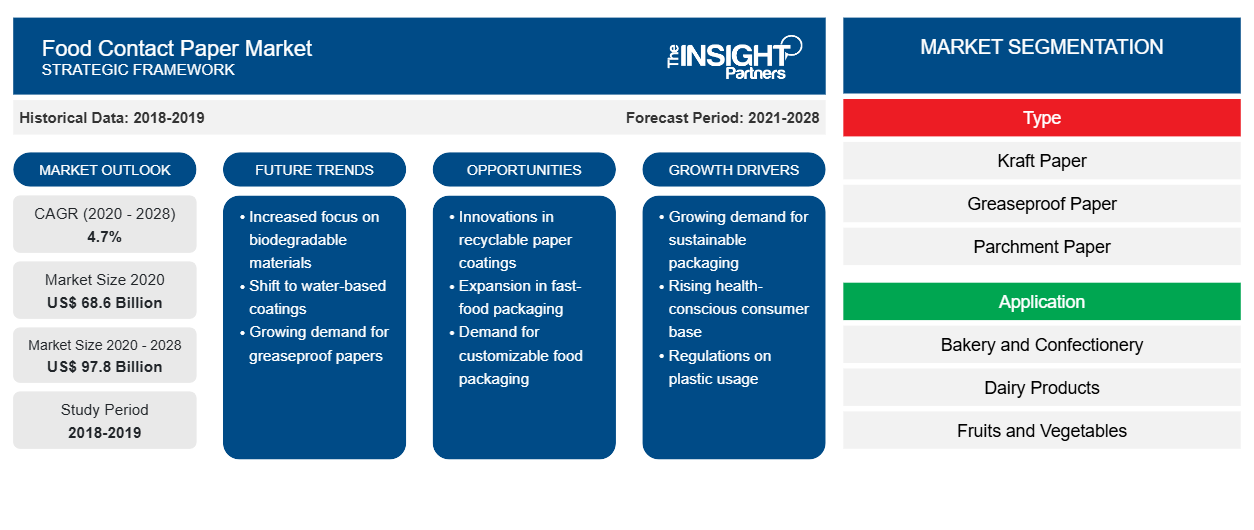식품 접촉지 시장 규모는 2020년에 686억 달러에 달했으며, 2028년까지 978억 달러에 도달할 것으로 예상됩니다. 2021년에서 2028년까지 연평균 성장률은 4.7%일 것으로 예상됩니다.
식품 접촉지는 구운 음식, 과자, 육류, 간식, 곡물 분쇄 제품과 같은 다양한 식품 제품의 주요 포장재로 사용됩니다. 이 종이는 플라스틱 및 유리와 같은 다른 많은 식품 포장재에 대한 지속 가능한 대안입니다. 탄소 발자국을 줄이기 위한 기업의 이니셔티브가 커지면서 전 세계적으로 식품 접촉지 채택이 영향을 받고 있습니다. 지속 가능하고 친환경적인 식품 포장에 대한 수요가 증가함에 따라 식품 종이 포장에 대한 수요도 증가했습니다.
2020년 아시아 태평양 지역은 글로벌 식품 접촉지 시장을 지배했으며 예측 기간 동안에도 지배력을 계속 유지할 것으로 예상됩니다. 아시아 국가의 성장하는 푸드서비스 산업, 환경에 대한 인식 증가, 여러 아시아 국가에서 플라스틱 포장을 금지하려는 정부 이니셔티브 증가로 인해 친환경적이고 지속 가능한 포장 솔루션에 대한 수요가 가속화될 것으로 예상되며, 이는 아시아 태평양 지역의 식품 접촉지 시장 성장을 촉진할 것입니다.
귀하의 요구 사항에 맞게 이 보고서를 사용자 정의하세요
이 보고서의 일부 또는 국가 수준 분석, Excel 데이터 팩을 포함하여 모든 보고서에 대한 사용자 정의를 무료로 받을 수 있으며 신생 기업 및 대학을 위한 훌륭한 혜택과 할인 혜택을 이용할 수 있습니다.
-
이 보고서의 주요 시장 동향을 알아보세요.이 무료 샘플에는 시장 동향부터 추정 및 예측까지 다양한 데이터 분석이 포함됩니다.
화학 및 재료 산업과 같은 많은 산업이 COVID-19 팬데믹으로 인해 전례 없는 어려움에 직면했습니다. 원자재 및 노동력 부족, 공장 폐쇄 및 COVID-19 안전 프로토콜에 따른 기타 운영상의 어려움으로 인해 포장 제품 제조업체는 팬데믹 초기 몇 달 동안 매출이 감소했습니다. 게다가 소비자의 라이프스타일 변화와 식습관 변화로 인해 바이러스 확산으로 인해 기성품 및 외부 식품의 소비가 감소하여 식품 접촉지에 대한 수요에 부정적인 영향을 미쳤습니다. 그러나 여러 국가에서 적절한 예방 조치로 봉쇄를 해제함에 따라 식품 접촉지에 대한 수요가 다시 증가할 가능성이 높습니다. 다양한 국가에서 봉쇄가 시행됨에 따라 전자 상거래 부문은 오프라인 매장의 폐쇄로 인해 신선한 야채와 과일을 포함한 포장 식품 및 식료품과 같은 다양한 제품에 대한 수요가 크게 증가하여 식품 접촉지 사용이 촉진되었습니다.
시장 통찰력
재활용 및 생분해성 포장 솔루션에 대한 수요 확대
생분해성 및 재활용 가능한 포장은 소비자와 제조업체 모두에게 일회용 포장 옵션에 대한 매력적인 대안이었습니다. 식품 서비스 포장은 미국에서 매립지에서 상당한 양의 폐기물을 발생시킵니다. 미국 환경 보호청이 발표한 보고서에 따르면, 식품 폐기물과 포장은 미국에서 매립되는 재료의 대부분을 차지합니다. 종이 포장은 생분해성이기 때문에 재활용 가능한 포장보다 선호됩니다. 재활용 식품 포장을 사용하면 오염 가능성이 높아져 환경과 인간 건강에 영향을 미칠 가능성이 있습니다. 전 세계 정부가 일회용 플라스틱 봉지 사용에 대한 이니셔티브를 늘리면서 재활용 가능하면서도 지속 가능한 포장 솔루션에 대한 수요가 늘어나 식품 접촉지에 대한 수요가 증가하고 있습니다.
유형 통찰력
식품 접촉지 시장은 유형에 따라 다음과 같이 세분화됩니다.크래프트지, 그리스프루프지, 양피지 등. 크래프트지 부문은 2020년에 가장 큰 시장 점유율을 차지했습니다. 천연 크래프트지는 순수한 버진 섬유를 가지고 있어 이상적인 식품 접촉 포장 솔루션입니다. 이 종이는 종이 봉지, 종이 자루, 포장지, 종이 접시와 같은 다양한 식품 접촉지 제품을 제조하는 데 점점 더 많이 사용되고 있습니다. 천연 크래프트지는 높은 강도로 인해 신선한 과일과 채소를 위한 식료품 봉지를 만드는 데도 점점 더 많이 사용되고 있습니다.
Mondi; Westrock Company; Georgia-Pacific LLC; Twin River Paper Company; UPM; Ahlstrom-Munksjö; GM Packaging (UK) Ltd; Superiorpaper Pty Ltd. TopCare; KRPA Holding CZ는 식품 접촉지 시장에서 활동하는 주요 기업 중 일부입니다. 주요 시장 기업은 합병 및 인수, 제품 출시와 같은 전략을 채택하여 지리적 입지와 소비자 기반을 확대하고 있습니다.
스포트라이트 보고서
- 식품 접촉지 산업의 진보적 추세는 플레이어가 효과적인 장기 전략을 개발하는 데 도움이 됩니다.
- 선진국과 개발도상국 시장에서 성장을 확보하기 위해 기업이 채택한 사업 성장 전략
- 2019년부터 2028년까지 글로벌 식품 접촉지 시장의 정량적 분석
- 다양한 산업에 걸친 식품 접촉지 수요 추산
- 산업에서 운영되는 구매자와 공급자의 효율성을 보여주기 위한 포터 분석으로 시장 성장을 예측합니다.
- 경쟁적인 시장 상황과 식품 접촉지 수요를 이해하기 위한 최근 개발
- 식품 접촉지 시장 성장을 촉진하고 제한하는 요인과 함께 시장 동향 및 전망
- 글로벌 식품 접촉지 시장 성장과 관련된 상업적 관심을 뒷받침하는 전략에 대한 이해, 의사 결정 프로세스 지원
- 시장의 다양한 노드에서의 플로트 유리 시장 규모
- 글로벌 식품 접촉지 시장의 자세한 개요 및 세분화와 산업 역학
- 유망한 성장 기회가 있는 다양한 지역의 식품 접촉지 시장 규모
식품 접촉지 시장 지역 통찰력
Insight Partners의 분석가들은 예측 기간 동안 식품 접촉지 시장에 영향을 미치는 지역적 추세와 요인을 철저히 설명했습니다. 이 섹션에서는 북미, 유럽, 아시아 태평양, 중동 및 아프리카, 남미 및 중미의 식품 접촉지 시장 세그먼트와 지리에 대해서도 설명합니다.

- 식품 접촉지 시장에 대한 지역별 특정 데이터 얻기
식품 접촉지 시장 보고서 범위
| 보고서 속성 | 세부 |
|---|---|
| 2020년 시장 규모 | 686억 달러 |
| 2028년까지 시장 규모 | 978억 달러 |
| 글로벌 CAGR (2020-2028) | 4.7% |
| 역사적 데이터 | 2018-2019 |
| 예측 기간 | 2021-2028 |
| 다루는 세그먼트 |
유형별로
|
| 포함된 지역 및 국가 |
북아메리카
|
| 시장 선도 기업 및 주요 회사 프로필 |
|
식품 접촉지 시장 참여자 밀도: 비즈니스 역학에 미치는 영향 이해
식품 접촉지 시장은 소비자 선호도의 변화, 기술 발전, 제품의 이점에 대한 인식 증가와 같은 요인으로 인해 최종 사용자 수요가 증가함에 따라 빠르게 성장하고 있습니다. 수요가 증가함에 따라 기업은 제품을 확장하고, 소비자의 요구를 충족하기 위해 혁신하고, 새로운 트렌드를 활용하여 시장 성장을 더욱 촉진하고 있습니다.
시장 참여자 밀도는 특정 시장이나 산업 내에서 운영되는 회사나 기업의 분포를 말합니다. 주어진 시장 공간에 얼마나 많은 경쟁자(시장 참여자)가 존재하는지 그 규모나 전체 시장 가치에 비해 나타냅니다.
식품 접촉지 시장에서 활동하는 주요 회사는 다음과 같습니다.
- 몬디
- 웨스트록 회사
- 조지아-퍼시픽 유한회사
- 트윈 리버 페이퍼 컴퍼니
- 유피엠(UPM)
면책 조항 : 위에 나열된 회사는 어떤 특별한 순서에 따라 순위가 매겨지지 않았습니다.

- 식품 접촉지 시장 주요 주요 업체 개요를 알아보세요
식품 접촉지 시장, 유형별
- 크라프트지
- 기름방지지
- 양피지
- 기타
식품 접촉지 시장, 응용 분야별
- 제과 및 제과
- 유제품
- 과일과 채소
- 고기, 생선 및 가금류
- 기타
회사 프로필
- 몬디
- 웨스트록 회사
- 조지아-퍼시픽 유한회사
- 트윈 리버 페이퍼 컴퍼니
- 유피엠(UPM)
- 알스트롬-뭉크쇼
- GM 패키징(영국) 유한회사
- 슈페리어페이퍼 주식회사
- 탑케어
- KRPA Holding CZ,
- 과거 분석(2년), 기준 연도, CAGR을 포함한 예측(7년)
- PEST 및 SWOT 분석
- 시장 규모 가치/거래량 - 글로벌, 지역, 국가
- 산업 및 경쟁 환경
- Excel 데이터세트
최근 보고서
관련 보고서
사용 후기
구매 이유
- 정보에 기반한 의사 결정
- 시장 역학 이해
- 경쟁 분석
- 고객 인사이트
- 시장 예측
- 위험 완화
- 전략 기획
- 투자 타당성 분석
- 신흥 시장 파악
- 마케팅 전략 강화
- 운영 효율성 향상
- 규제 동향에 발맞춰 대응























 무료 샘플 받기 - 식품 접촉지 시장
무료 샘플 받기 - 식품 접촉지 시장